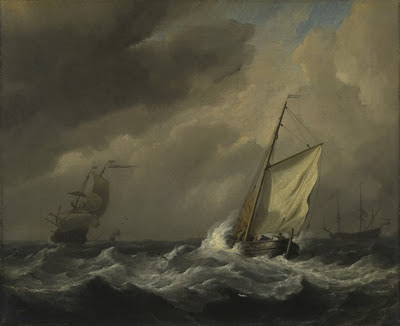 |
| Three Ships in a Gale 1673 |
Many of his paintings were about the open seas. "A Gale" was a painting in 1673 of Holland's naval power and trade. It is hosted at the National Gallery in London. Within the picture it is easy to see the waves washing over the fishing-smack and a frigate approaching in the background. The seas represented both ferocity as well as economic opportunities. Many investments were lost and made on the open seas. Such ships were subject to being lost at sea, attacked by other naval powers, disease, or slaughtered at port by hostile locals. This period was one of romantic danger and historical heroes.
Dutch shipping in this period included silk, gold, copper, textiles, spices, coffee, tea and sugar. The population in Holland exploded along with the shipping from 30,000 people in 1565 to 100,000 people in 1630. The majority of workers on these ships were immigrants who were attracted to the high pay despite the risks associated. Much of the trading was between Indian and Holland.
The Golden Age of Dutch shipping existed between the 16th – 17th Centuries. At which time it began to wain as English shipping encroached on the Dutch powerhouse. The Dutch East India Company, Vereenigde Oost-Indische Compagnie, started in 1602 and ended in 1796. It was one of the first mega-corporations that held governmental powers and could wage war, imprison people, execute convicts, create money, establish colonies and even negotiate treaties. The power of this company was enormous during this time of Dutch society.
No comments:
Post a Comment